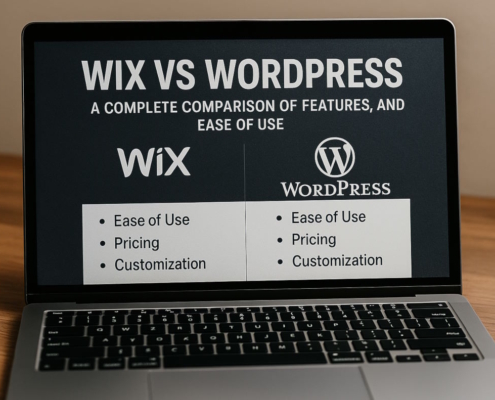The top free website builders
1. Google Sites
Google Sites advantages:
- Straightforward (for example, Google Docs)
- Perfect for team projects
Google Sites drawbacks:
- Do not have any SEO tools
With no search engine optimization features and few personalization choices, Google Sites is a stripped-down website builder. Although it is OK to use if you are just starting out or if you simply want to test the waters, you should not anticipate dominating the search engine results. Also, if you’re looking to move away from the old Google Business Profile websites, it’s a good alternative.
If you’d rather start from scratch, you have your pick of twelve different templates. Then, choose from six premade themes or make your own to fine-tune the appearance (color, style, and fonts). You won’t have much leeway to customize a standard theme. To make an orange button, for instance, you’d have to alter the theme color, which may have an effect on other color preferences. All of the settings are preset, including the button size. To get around the limitations, you’ll need to make your own theme.
However, getting the hang of Google Sites is a breeze. Similar to Google Docs, you may save your work to Google Drive before publishing your site and then share it with others. The lack of search engine optimization options is a bit odd, but creating a unique URL for each page is possible. (Perhaps you must have faith that Google will take care of the SEO.)
- Cost: Google Sites is completely free; there are no premium options.
- Ease of use: No learning curve required. Quite similar to how Google Docs works.
- Options for customization: Few. Personalize your site’s appearance with one of twelve available layouts and six available themes. Perfect for those without extensive knowledge of website development.
- Search engine optimization tools: Surprisingly, none.
- Free plan value: Minimal. Appropriate for amateurs and newcomers, but can’t compare to Yola or Wix in terms of quality.
Conclusion: Most straightforward free website builder for basic websites.
2. Yola
Pros of Yola:
- Very user-friendly
- A large and useful collection of building blocks
Cons of Yola:
- Minimal SEO configuration
Yola is the greatest no-fuss website builder, and it deserves the title. After you choose your desired website type (personal, company, retail, or community) during setup, you’ll have the option to use an automatic AI builder or choose from a variety of do-it-yourself templates. The great part is that you may change the template whenever you want without erasing any of your previous work. (Yes, it sounds trivial, but it’s not always easy to tell which of several available templates is going to be the greatest fit for your site.)
Every one of the business themes has all the necessary components for a professional company website. Here are some key features of the marketing agency template: a powerful header component, logos of clients, services given, comments from clients, a little about us, and a call to action just before the last section. Also, the AI-powered website builder is pretty good.
Using Yola’s block editor is a breeze. Arranging blocks on your website is as easy as pie. Additionally, Yola stands out from other website builders with its extensive block library, which includes features like a logo wall, a call to action, a frequently asked questions section, and services. Only by manipulating parameters can you alter specific components, like the color of a button, for example. If you really wanted red buttons instead of blue, for instance, you’d have to alter your site’s color scheme entirely. However, this ensures that your website design remains polished and not sloppy like a kindergarten project.
There is a lot of thought put into the coordinated use of color schemes, font families, and button designs. That way, you can see the effects on your website right away and experiment with different color palettes until you discover one you love. (You can easily discover a palette that suits you because there are 70 to choose from.)
As is typical with free site builders, your site will include Yola advertisements and a domain if you go with the free plan. A custom domain connection costs $6/month and Yola branding removal costs $14/month, so the premium plans aren’t too pricey. However, it is recommended to use one of the other applications on the list if your needs exceed what this tool can provide.
- Pricing for Yola: There is a free plan, and paid plans begin at $6.95/month (charged annually).
- The ease of use: The editor is easy to use and understand.
- You may personalize it by choosing an AI builder or a premade template, then editing the parts with easy-to-understand on-screen instructions.
- SEO tools: Not a ton, but enough. Adding custom code requires an upgrade, however adding a standard title and meta description is free.
- The free plan is worth it. You may personalize it to your liking by upgrading to remove the Yola logo.
3. Wix
Pros of Wix:
- Experienced website builder that offers a wide range of integrations
- A user-friendly AI builder
Cons of Wix:
- It has its moments of being sluggish to work with.
Is the excitement around Wix, one of the most well-known drag-and-drop website builders, justified? Wix is a good option if you just want to make a simple website with a few features and don’t want to make a lot of choices.
To begin setting up your site without AI, simply inform Wix of the sort of site you desire and any other features you might require, such as a blog, forms, chat, or an online store. The next step is to choose a template from more than 900 designs, organized by category. Each one is adaptable to your specific requirements and exudes an air of professionalism.
While filling out the initial form, the template loads slowly. But you’ll see why once you start editing the template—the editor is surprisingly powerful for a free website builder. Customize your site the way you want it by dragging and dropping sections, changing fonts, adding headers, and including lists. There is no need to code or navigate between tabs.
Wix also has an AI option that you can use to build your site. You may obtain individualized tools, pictures, and text for your site by answering questions in a ChatGPT-like interface. The process is more time-consuming than other AI-powered website builders (mostly due to the increased number of questions), but the end result is a more contemporary and edgy style. Regenerating it is an option, though, in case you are unhappy with the outcome.
Launching a digital marketing campaign is a breeze with Wix because of its many connectors, one of which being email. The amount of things you can do without spending a dime is truly astounding. Note: You can add your own photos or choose free photos from Wix and Unsplash. However, some of the photos are from Shutterstock and cost money.
Never worked as a copywriter before? Coming up with engaging content for your website may be a real challenge. The fact that Wix recommends text is fantastic. You may use the AI Text Creator to generate good-sounding suggestions just by telling it what you want to say.
While it won’t be able to fully replace the services of an SEO specialist, Wix’s comprehensive SEO tools will give you a leg up in the search engine rankings. Inside Wix, you can even manage advertisements and make a marketing calendar. For entrepreneurs that are too busy to master a plethora of platforms, this is an ideal solution.
The next step is to go live with your site once you’ve made any necessary changes, such as adding pages and revising the text. A domain name ending in “.wixsite.com” and the Wix logo are the basic freebies you get from Wix. Of course, you may link your own domain if you have one.
- Wix pricing: You may get a free plan, and premium options start at $17/month.
- Usability: A drag-and-drop editor that is easy to use. There is a free AI website builder available in case new users are intimidated.
- Personalization choices: You may personalize it to your heart’s content with plenty of options for forms, eCommerce features, a blog, and even videos.
- SEO features: A good number of them! Even with off-site technologies like Google Analytics, Wix does a great job of describing the function of each component and walking you through the process.
- Free plan value: Outstanding. The free plan on Wix provides most functions to a certain extent, unlike other builders that try to upsell you on every other feature.
Conclusion: The top free website builder for expanding companies.
4. HubSpot CMS Hub
The advantages of HubSpot:
- A detailed blueprint for getting started
- A simple and fast AI builder
HubSpot drawbacks:
- Need to get rid of the awful default URL and use your domain instead
HubSpot’s free website builder maintains the platform’s reputation as a popular choice for marketing, sales, and support teams. The plan that shows you how to design your website step by step, with percentages to represent your progress.
Your site’s page layouts, modules, and style settings should reflect your brand, so choose a theme first. There are hundreds available on the marketplace, some of which are expensive and others free.
Another option is to utilize the AI builder, which will generate a website according to your specifications and the style you choose (such as modern, bright, or minimalistic). In a short amount of time, it generates a highly relevant site with an excellent design and content and image selection.
The next step is to apply your brand’s colors, fonts, and layouts to the theme’s settings. Take color schemes as an example; you may make your own or alter current ones. After that, select a regular header and footer layout and set up the popular pages (home, about, contact, etc.) to begin constructing your site. HubSpot goes so far as to offer a comprehensive guide on how to use the drag-and-drop editor. Included in the 47 available modules (components) are the following: header, text, picture, accordion, and call-to-action.
By including features like powerful search engine optimization (SEO) tools and an emphasis on blog creation, HubSpot CMS clearly targets business sites. Before you even publish any entries, there’s a specific setup stage where you can define your blog’s title, URL, and description. This way, it will appear correctly in search engines. After that, you’ll need to input a plethora of typical on-page SEO settings, such as the page’s title, description, URL (including canonical URL), language, featured picture, and extra code snippets for the header and footer.
As you continue to add content to your website, HubSpot will also give SEO advice and flag any issues that require your attention. You can rest assured that HubSpot will handle all aspects of your inbound marketing strategy. Replace the unattractive default URL (yoursite.hubspotpagebuilder.com) with your own domain name.
- HubSpot CMS pricing: $0/month with a free plan and $15/month with an annual billing cycle.
- Usability: Simple to operate. Everything runs smoothly. Presented with explicit instructions.
- Personalization choices: Make your site unique by choosing from 47 modules (components) and hundreds of paid and free designs.
- SEO tools: Get suggestions for search engine optimization while you write content for pages. You may add code snippets to the header and footer and choose a canonical URL to make it even more personalized.
- Value of the free plan: An excellent jumping-off point. If you would like to utilize a custom domain with a more pleasant and easy-to-remember URL and have the HubSpot logo removed, you might consider upgrading to the premium plan.
Conclusion: The top free alternative to WordPress for professional designers
5. Webflow
Advantages of Webflow:
- Countless personalization choices
- Integrate third-party tools and widgets to expand functionality
Cons of Webflow:
- Absence of an AI developer
With hundreds of premade layouts and intuitive drag-and-drop editors, a few of these free website builders are a dream to work with. Webflow is not that. After you sign up for Webflow, it will inquire as to your role ( website builder, marketer, etc.) and whether or not you have any knowledge of CSS or HTML. These steps are great for making the site easy for everyone to use, but they didn’t quite work.
You may choose from a few free themes or pay for one that simplifies the building of your site (like WordPress). In addition, the platform comes with an optional walk-through and email lessons that can help you get to know it better. Everything should work out OK if you’re familiar with WordPress and how styles and classes work. However, you may find it challenging to gain traction if you are unfamiliar with website builders.
In any case, that’s hardly surprising given the abundance of features and personalization choices. Among the many options available are the following: centering, horizontally stacking containers, changing fonts, adding buttons, adjusting the height, among many more.
When it comes to search engine optimization, all the tools you need are at your fingertips, including meta descriptions and title tags. To add the meta description, for instance, you need to go to the main page panel, click on the page, click options, and then you’ll see SEO settings. However, they aren’t exactly easy to locate.
As an additional perk, Webflow is a great alternative to WordPress since you can extend its functionality with various connectors and widgets. These may help you with targeting, spam limitation, customer engagement, CRM management, and a whole lot more. As far as free site builders go, it’s not the most user-friendly, but it packs a serious punch.
- Pricing for Webflow: There is a free plan, and paid plans start at $14/monthly (billed annually).
- Usability: Not recommended for beginners. While they do include a tutorial and templates, Webflow isn’t the best choice if you’re seeking a simple drag-and-drop builder. However, if you’re familiar with Elementor or another WordPress page builder, you should have no trouble.
- Personalization choices: You’re essentially starting from zero when it comes to personalization, but there are a ton of options.
- SEO tools: All the features you want are available, but they may not be immediately apparent. It could be difficult for people who aren’t SEO experts.
- Value of the free plan: You can use all of its features and get a Webflow.io name and up to 50 CMS items for free.
6. Webnode
Web node benefits:
- Machine learning creates a unique website just for you
- Pleasant, uncluttered user interface
Cons of Webnode:
- No granular headings for text formatting
With the addition of AI, Webnode has become an even more user-friendly website builder.
Everything about the design process is simple. Pick between a website, an online store, or a blog as your first choice, and then select whether you’d want to build your site from scratch or use AI-powered tools. You can’t go wrong with either choice.
In order to use AI, you need to provide certain information on your website, the pages you need, and your company. When you tell the AI builder what you need, it will make three different versions; from there, you may pick the one that best suits you. On the other hand, there are more than 150 templates to pick from, and they all have fantastic designs.
Editing your site is completely up to you, regardless of the option you select. Make use of the section settings to alter the backdrop (image, picture, color, etc.), the site settings to alter the color scheme or button designs (shadow, rounded corners, border, size, etc.), or the drag-and-drop editor to rearrange items (videos, lines, forms, etc.) on the page. The one drawback is that while modifying text components, you can’t use granular headers (H1/H2/H3, etc.).
There is no distracting sidebar, and the design is clear and easy to use, making it stand out from other site builders. Simply click on the item you wish to update and make the necessary changes. On top of that, you receive all the typical SEO options for every page.
- Pricing for Webnode: There is a free plan, and paid plans start at $4.50/month.
- The ease of use: The UI is neat and simple, making it easy to use.
- Personalization choices: Modify preferences for the entire site or for specific pages. Use the drag-and-drop editor to reposition components.
- SEO tools: Top-notch. You may customize the header and footer code, as well as the URL, meta title, and meta description, for every page.
- Free plan value: Fantastic, with 150+ templates and AI features to kick things off. You should consider upgrading so you may use your own domain name and eliminate the Webnode logo.






























